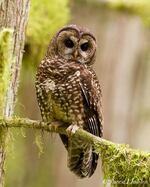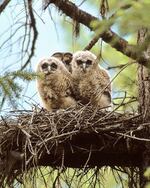
A male spotted owl in flight, photographed in 2010. This owl and his mate live along are among the last few pairs to survive in the wild in Canada. They live on the east side of Anderson Lake, about 130 miles north of Vancouver.
Jared Hobbs
In the U.S. the number of northern spotted owls is shrinking every year. But there’s still a healthy population, about 7,000 birds, in the wild. Across the border in Canada, less than 20 adult spotted owls have been counted in recent years. And that’s led the government of British Columbia to start a controversial captive breeding program.
When the High Desert Museum in Bend first designed an exhibit for its pair of spotted owls, it wasn’t thinking about bird romance. Raptor expert Jim Dawson manages the live animals at the museum. He raps on the bullet-proof glass of the owl enclosure.
“The exhibit was actually originally built to provide top security for a species that some people might want to harm, and as it turned out it was an excellent breeding set up for them.”
The museum’s spotted owls, Polka and Dot, raised three broods of chicks in an old growth snag made of concrete. Polka and Dot have both died of old age. But they’ve made their contribution to spotted owl recovery. Two of their chicks were sent to a captive breeding center in British Columbia. Biologist Eric Forsman put on protective headgear and hand-placed some of the chicks into wild foster nests.
“You’re trying to duck the adults because they’re usually bombing the heck out of you." Forsman says. " You’re getting beat up as you go up the tree. You put the little juvenile bird into a box so it’s protected and then you pull it up with a cord and stick it into the cavity.”
Forsman works for the forest service. He’s the country’s top spotted owl biologist. Once you get the chick into the nest, he says, the adults don’t seem to mind feeding an extra hungry mouth.
“Two different years we introduced birds into those nests. And two of those birds, at least as of last year were still alive.”
Captive breeding and release to augment wild populations has been used to help a handful of critically endangered species. There’s the California condor, the peregrine falcon, the Mexican wolf. Jim Dawson, at the High Desert Museum, says it hasn’t been part of the plan to recover spotted owls in the U.S. And he thinks it should be.
“You know, right now with the shape the species is in, it’s a little disturbing that we haven’t learned how to captive breed them and do it successfully, and in numbers. And that’s something we need to work on” Dawson says.
The spotted owl population continues to decline, especially as you travel north. The endangered birds are hanging on in Oregon, but in Washington state the population gets smaller by about 7 percent each year.
“In only ten or twenty years, you’re just about out of owls,” says Eric Forsman, describing it as population crash.
And in British Columbia, the northern tip of the bird’s range, there are only three known pairs in the wild. That’s down from an historic high of around 500 pairs. Ian Blackburn, who leads the spotted owl recovery team in British Columbia, says captive breeding was the best chance for the species in Canada. In 2007, the team captured some of the last remaining wild spotted owls.
“It was purely a numbers game, there were so few spotted owls in the wild in B.C., that the likelihood that they would just naturally find each other and breed was very low.” Blackburn says.
Blackburn says owls live longer, and can breed more frequently in captivity. The recovery team’s goal is to breed 60 spotted owls. At that point the government will start releasing the birds back into a few protected areas.But there’s a problem. The male owls just aren’t doing their job.
“we’ve always been able to produce eggs, that hasn’t been an issue. The challenge is producing fertile eggs” he says.
So far the program has hatched just two chicks. Environmental groups in Canada say the breeding program is pointless at best, because the government still allows logging in old growth forests. Blackburn says there’s enough forest habitat left to support his target of 60 owls. But he also confirmed that the year the program started, in 2007, a forest stand was logged. It was part of the territory of one the last spotted owls in the wild. Biologist Eric Forsman helped British Columbia start its captive breeding program. After a while, he decided not to be involved.
“You know, I became concerned that it wasn’t going to do you much good to do captive breeding if you weren’t willing to protect the places where those owls settled” Forsman says.
Forsman says that even just doesn’t think captive breeding is going to do much for this species, even if it’s combined with serious habitat conservation. The spotted owl is now facing competition from the barred owl. It’s an invasive species that’s aggressively chasing spotted owls out of their territory. Forsman says the barred owl is part of what pushed the spotted owl to the brink in British Columbia.
“There’s no easy way to remove barred owls from the environment. So even if you bred spotted owls in captivity, they would probably have a hard time finding a place to live since much of the landscape is now occupied by barred owls.”
Given the arrival of the barred owl, Forsman says, the spotted owl population is going to shrink. And there may not be much we can do about it.



